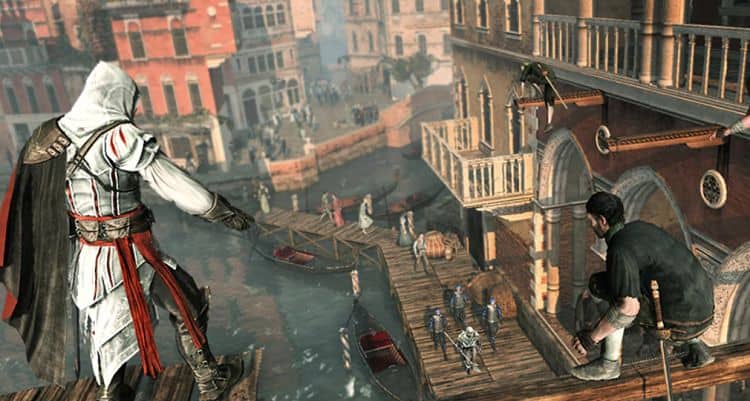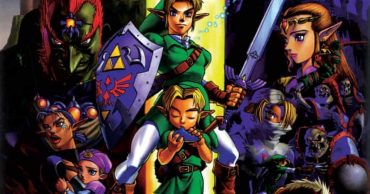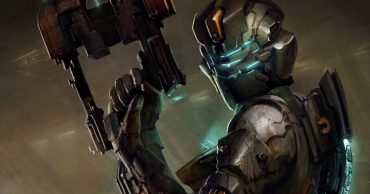
Assassin’s Creed may have laid the groundwork for the parkour era of stealth-based, open-world gaming that it’s hard to avoid today, but Assassin’s Creed II took the blueprint and made it into something special. The results are a concept still being copied, torn apart, and improved today with industry behemoths such as Spider-Man, Shadows of Mordor, and Ghost of Tsushima. Why, then, did it take me more than a decade to give it more than a passing glance?
As a completionist to an absolute fault, I often struggle latching onto a franchise that I wasn’t on board from the get-go. As such, I start a game like Assassin’s Creed: Black Flag. I feel the irrational urge to start from the beginning, as not to miss important lore and backstory. This quirk and fault is nothing new, but most franchises beyond repetitive sports games don’t release their games at Ubisoft’s clip. However, after diving off the mental ledge and plunge into Ezio’s adventure, I realized why Assassin’s Creed II marks the start of the franchise, genre, and trends in gaming that still carry over today.
A rundown of a list such this one at Happy Magazine, shows two dominant families of third-person, stealth-based adventure games. Games like the Hitman and the Arkham series have players picking off their prey one by one as they quietly move toward the finish line before an unlucky soul discovers the first body.
On the other hand, Assassin’s Creed (and all its copycats) offer fast-paced worlds where stealth is less a means to an end more a means to the precipice of a loud and bloody battle with a couple of free hits before it. While both genres bleed into the other. In recent years, game makers have blurred these lines, with Ghost successfully finding the middle ground which allows people to choose either side with pros and cons, depending on the battle.
It was a decade-plus-long journey from the basics learned in AC2 to the mostly flawless engine that runs Ghost. Now, playing Ubisoft’s groundbreaking sequel is less a workshop in frustration than one might think. Assassin’s Creed II hilarious reminder of how far gaming has come since 2009.
Tsushima’s combat engine operates like combat-based chess. From figuring out the proper stance against a given enemy to knowing exactly when to parry, evade, block, or counter their next move. After playing and winning on the hardest difficulty, I had to unlearn everything it taught me. However, as any gamer knows, unlearning a decade of muscle memory that’s adjusted to the sleeker control schemes and more intelligent AI of today. Then again, nobody goes to Assassin’s Creed for a Stephen Hawking physics lesson, nor do they do so for a crash course into fundamental combat. As such, playing Assassin’s Creed in a post-Tsushima world can be as hilarious as it is impressions.
Despite its inevitable pitfalls, Assassin’s Creed 2 remains a stunning technical achievement. Yes, it has the cardboard cutout NPCs that many games still suffer from today. Still, the overall landscape of Venice, Rome, and the rest of the Italian countryside is a vibrant, lived-in, and most stunning replication of the types of worlds we see in Hollywood movies. While the Ezio collection’s Remaster irons out some faults, the core of the original remains remarkably similar. Thanks to the heavy-handed Da Vinci subplots and blink-and-you-miss-them historical Easter Eggs, the world of Assassin’s Creed II deserves as much credit now as it did at its release in 2009.
For all its quirks, the gameplay remains as entertaining and impressive as it is clunky and frustrating. Although the combat is straightforward — if I have died in battle 25 hours in, I don’t remember — it’s still fun having the enemies circle around the player like they’re Jet Li getting ready to dispose of them with an impressive arsenal of renaissance weaponry. Where the combat engine entertains the most, however, is when it shows its age with all its glitches, guts, and glory.
Ever since my introduction to the Zelda universe, A Link to the Past, I’ve been a strong proponent of the “knock the enemy off the edge and watch them plummet” strategy. This comes in handy when I find myself in a pickle. Assassin’s Creed II sets the table for so many intriguing combat options but fails to anticipate how gamers can exploit them and use them after 12 years of improvements and expansions to the genre.
For a game boasting a lively, vibrant recreation of an idealized 15th-century Venice cityscape, one might expect the enemy to have basic swimming abilities. After all, swimming goes back as far as the medium itself. Instead, Assassin’s Creed II gives gamers a city filled with waterways and an onslaught of guards who will turn into the Wicked Witch of the West inside a glorified puddle. Got a dozen guards on your trail? Jump into the water right in front of them and watch a third of them plummet to their watery grave while the others pause to wonder where you went.
The same can be said with the notion of gravity. For a game whose parkour movements revolutionized the genre as we know it, the transition between running the streets of Rome and fighting off whatever guards are in your path can be the clunkiest area of the game. Some of this is a given. Assassin’s Creed II is as much a puzzle game as it is a stealth-based combat one. As such, certain jumps and leaps and falls you try will make you hit the stony streets or marble cathedral floors as though its star’s innards consisted of stone and concrete pellets. Once you master this flaw within the engine, it shifts the tide to something you can use.
Early on, when the guards disagreed with my decision to commit murder, I climbed a ladder that led to a dead end. Rather than ending things there, the compassionate keepers of the Law lined up single-file by the ladder. They allowed me to push each man to the great beyond with minimal concern from both their co-workers and the civilian passers-by beneath.
Retro gaming can be a mixed bag. While games like Tony Hawk are better left being remade, Ubisoft justifies leaving the game’s mechanics as is by letting us use its flaws to our advantage.
Does this always work? Nope. Next time I try to jump across a two-foot chasm only to take a 45-degree sleep the other way, I may consider suing them myself. However frustrating and amusing it is, the second chapter shows why it remains a favorite of the fast-paced, stealth-based action-adventure genre.
The Assassin’s Creed franchise may never be the same again after Infinity. As such, nostalgic gamers craving the magic of its origins can pop in the Ezio Collection, slog through the modern-set introduction, and enjoy a game that wears its age with pride, hilarity, and occasional embarrassment.
 Follow Us
Follow Us





